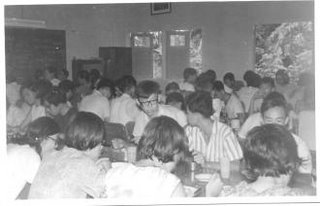Chui Arm Lor
The kampong where we used to live in was popularly known as Chui Arm Lor in Hokkien, meaning Water Pipes Road. It joined Lorong Chuan to Upper Thomson Road. On the way, it crosses the Kallang River 9 times; hence it was also called Kau Tiao Kio or 9 Bridges
.
Before Lorong Chuan was constructed, it was a mud track that joined directly to Braddell Road. At that time our address was 288 Ang Moh Kio. In order to get to our school, Braddell Rise Primary which was located next to Mt Alvernia Hospital, we had to cycle from our house out to Braddell Road, chain it to a lamp post or roadside railing, and take a bus to school. Usually, my elder brother, David would do the cycling and I would ride on the back seat. I remember one very yucksy incident that happened one morning. As we overtook a bike in front of us, the chap decided to turn aside and spit. Guess where the projectile landed – yes right on me; exactly which part of the anatomy, I cannot recall. But you can understand why it was an unforgettable experience.
I cannot recall which year Lorong Chuan was built. It joined Braddell Road to Ang Sar Lee. I think most adult Singaporeans know that’s the Hokkien name for Seranggoon Gardens. At the time when construction was nearing completion, many Ang Mors liked to use it for go-kart practice. That was quite an eye-opener for us kampong kids. With the completion of Lorong Chuan, we did not have to go to the market at Lim Tua Tow Road at Gor Ko Chio (5th Mile, Upper Seranggoon) to do our marketing. Instead, we did our marketing at the Seranggoon Gardens Way Market , located opposite the post office. Sometimes I was tasked to do the marketing alone; which meant I had to cycle to SG and back. I picked up some skills in selecting pork and vegetables then.
After Lorong Chuan was completed, our village was renamed Lorong Kinchir, and our house address was also changed to 21-A Lorong Kinchir. Below is a sketch of our neighbourhood. After some consultation with my eldest brother, Chun Chew who has an uncanny ability to remember all sorts of details about our childhood days, I believe the diagram below is more than 80% accurate.
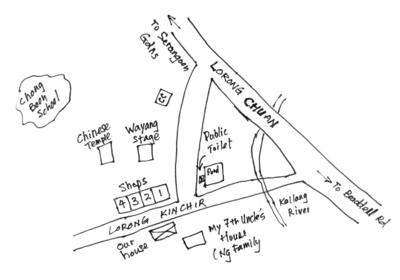
Say Kai Hor
Now, can anyone guess what is that?
It is the Cantonese name we gave to the Kallang River. Literally, it means Dead Chicken River – no prize for guessing how it earned such a colourful name. Every time we crossed the bridge, we had to hold our breath because, not only chickens, but dogs and pigs were discarded into the river. Better not go into any more details.
Would you believe that we have actually seen kids frolicking in the waters of the Sai Kay Hor. We ourselves have waded in, occasionally to catch blood worms for our fighting fish. We do this by running a metal wire through the sand. When the wire emerges, some blood worms will be found handing to it. We have also seen men with big cans and nets catching blood worms on a bigger scale. By the way, my teenage son who regularly goes for kayaking training at the Kallang River often jokes about the stench and filth. Wait till he reads this blog.
The recent news about the Katrina Hurricane in US, reminded me of an incident concerning the Dead Chicken River. I saw a news report in CNN concerning the floods in New Orleans, where people were warned to be on the lookout for alligators. One year, there was widespread flooding in Singapore; and many of us were also warned to look out for a crocodile that had escaped from the crocodile farm in Lorong Chuan. The location would be near the present junction of Ang Mo Kio Avenue 1 and Lorong Chuan. If you have been to Lorong Chuan those days, you will know what I am talking about. The stench from the crocodile skins can be detected from miles around.
Our House
Below is a picture of our house. The design was quite unique. If fact, one year, it was featured in one of the primary school geography books. Our house was also one of the few houses that had a well. Before tapped water became available, many of our neighbours came to our house to help themselves to the water which was probably of the highest quality in the whole village. The well was located just to the right of the photo.
To the left of the picture was a very old durian tree with lots of dragon scales growing along its trunk. Before you start to envy us, I must tell you that this tree was really not very fruitful. Each season it only bore a couple of very small fruits. Every time, the thud of the falling durian was heard, we children would race each other to get to the fruit. Perhaps it was due to the scarcity of the harvest that our durians seemed to be especially tasty.
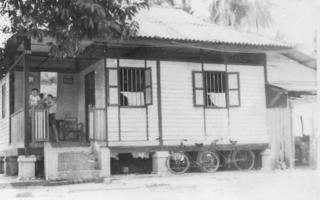
This photo was taken using our very first camera - a Kodak Brownie. It must be taken around 1957 or 58 becaue I (the kid on the left) looked no older than 5 or 6.
The drainage those days was quite bad. Hence there were mosquitoes every where. At night, we needed to sleep with the mosquito screen all around. Even then, when morning came, you can find yourself in the company of several swollen, lazy mozzies, which was why our screens tended to have patches of blood on it. Mosquito breeding was so rampant that we could easily catch mosquito larvae from the drains to feed the fighting fish which we caught from the nearby ponds. However, we never knew of anyone catching dengue fever.
Our Neighbours
The main road, Lorong Kinchir ran in front of our house and across the road was a row of 4 shops.
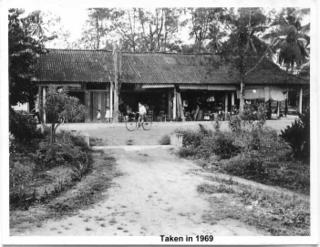
Shop No. 1 (from the right) was a coffee shop. The owner was called Hock Chek (Uncle Hock). He was in fact my godfather although he hardly ever spoke to me. I was much closer to my godmother though (Hock Chim). Sometimes, I would volunteer to buy coffee from them. Those days, 1 big mug of kopi-O cost 10 cents. If my godmother was on duty, I usually get to pocket the 10 cents.
I can recall some interesting things about the coffee shop. For example, they used saw dust to keep the ice blocks from melting. Occasionally, they also roast their coffee beans in front of the shop. The coffee beans were mixed with butter and roasted in a cylindrical drum which was rotated by hand. The aroma reached even to our house.
On rare occasions, we gave ourselves a treat to a bottle of Pepsi-cola here. We liked to add lots of salt from a small Brand’s essence of chicken bottle, and listen to the sizzle as the salt crystals hit the cola. The taste was so wonderful that I promised myself that some day, if I could afford it, I would drink Pepsi everyday. Of course that was one promise I did not keep.
Shop No. 2 was a provision shop owned by a man called Tua Tau (big head). We bought much of our foodstuff from him on credit. Whenever, we buy something, we would bring along a small 555 booklet (I think you can still find those today) to record the amount and the shopkeeper will also record in his ledger. It was then that we learnt how to recognize special Chinese characters for numerals (different from the normal Chinese writing).
Shop No. 3 belonged to a guy called Ah Goo (buffalo). I can’t remember what they sold, but I certainly remember the multi-colour ice balls that we loved. I think he also sold sweets and other snacks. One sweet I remember was the coconut sweet. Sometimes if you were lucky, you can find a sweet with a 5-cent coin embedded to it as a mystery prize. I believe Ah Goo’s family were Teochew. I think he was quite a handsome bloke who attracted the attention of some of the village lasses. Our village were mostly Hokkiens. We were about the only Cantonese family; until my 7th Uncle moved in with his 9 children. After that, our standard of English improved tremendously, but our Hokkien deteriorated. I am not sure why my father chose this place and not Potong Pasir which was predominantly Cantonese. I think my eldest brother would know.
Shop No. 4 was a barber shop. The owner was a very quiet guy. His family kept very much to themselves. I believe they were Hock Chew. They were probably Catholics because they had a portrait of Jesus Christ hanging on the wall. Every afternoon, we would go over to borrow the Chinese newspapers from him so that our brother David could read to us the 武侠 stories. David’s Chinese was the most kilat of the lot. One year, he got a book prize for topping the whole level in ACS in Chinese. The title of the book was 中国名人故事 - Stories of famous Chinese personalities. I learned about 李白 and 白居易 's immortal poems from this book.
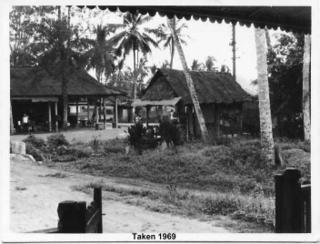
Shop No. 5 was on our side of the road facing Shop No. 1. It was a small coffee shop with attap roof and no walls. We called the owner Fook Chow Lou (Hock Chew man). I often bought snacks like tau sar piah from him. At one time, there was a stall beside this selling You Char Kueh (You Tiao). We enjoyed watching the man prepare the you tiao. From the picture above, you may also be able to make out the public toilet located next to a pond (please refer to sketch above). Did you know that we made our deposits directly into the pond!
Well that’s all I have to tell you about the village my siblings and I grew up in. The next time you travel on the Central Expressway from Ang Mo Kio towards Braddell Road, look to the left and try to picture the kampong we called Chui Arm Lor.
I hope you enjoyed reading this blog. If it stirs up some fond memories for you, please share them with us.
I also have some good news for you. I managed to persuade my old friend Tan See Jong (Safti Lima & Romeo coy, 1971) to contribute an article about his childhood surroundings in a place call Genting Lane. Look out for it.
Reach out for the joy and the sorrow.
Put them away in your mind.
For memories are time that you borrow,
To spend when you get till tomorrow.
 The 1-week camp in 1969 was very enjoyable and memorable. We did a lot of trekking and I remember seeing many rubber plantations and small Chinese temples. We also heard stories of people being bitten by hornets.
The 1-week camp in 1969 was very enjoyable and memorable. We did a lot of trekking and I remember seeing many rubber plantations and small Chinese temples. We also heard stories of people being bitten by hornets. 
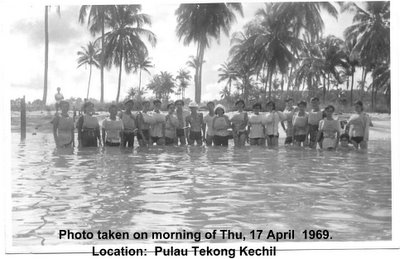 (By the way, the chap on the extreme left is me)
(By the way, the chap on the extreme left is me)